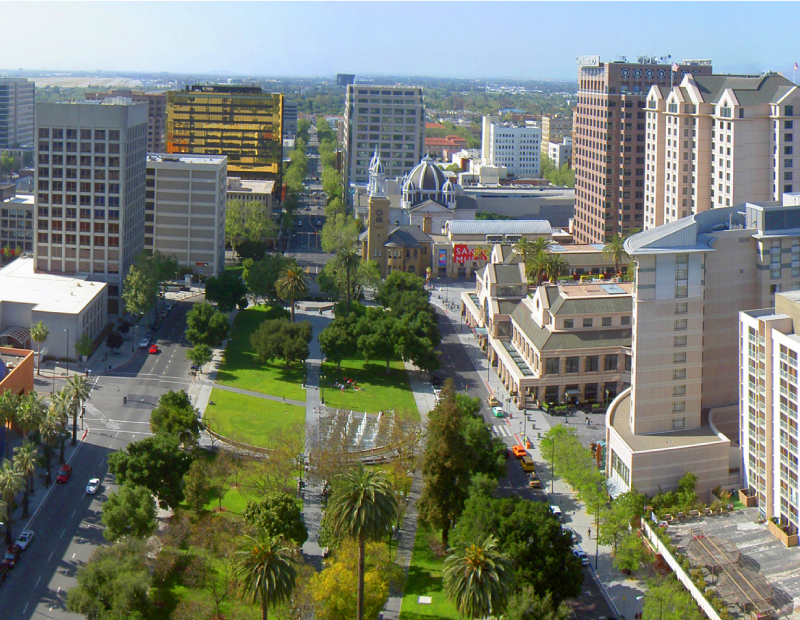Top 5 Markets for Office Transaction Volume
These metros account for more than 40 percent of the nation’s 2020 sales volume through October.
Investment transactions in the office market lost steam throughout the country year-to-date through October. Investors closed deals totaling $43.6 billion, almost half the total for the same period last year, according to CommercialEdge data.
One clear trend this year is investors’ increased interest in stabilized office markets. The five metros on this list accounted for more than 40 percent of the nation’s total transaction volume. Meanwhile, sales activity stalled in smaller markets such as Wilmington, N.C., Syracuse, N.Y., and New Orleans, La., following four quarters of consistent deal velocity.
5. Bay Area
Investors closed 58 deals in the Bay Area year-to-date through October for a total of $3 billion, which marks a 59.7 percent drop from the same period in 2019 and the steepest decline among the five metros on this list. Swift Real Estate Partners was the Bay Area’s top buyer this year so far, closing two deals totaling $401 million. In the first quarter, the company purchased the 350,000-square-foot Hellyer Oaks Technology Park from Vertical Ventures for $55.7 million. Later in the year, Swift paid $346 million to DWS for the two-phase Results Way Corporate Center in Cupertino, Calif., in the metro’s largest transaction over the first 10 months of 2020.
The Bay Area has long boasted a thriving office market, thanks primarily to tech giants offering high-paying jobs and attracting a highly qualified workforce. This resulted in an increase in both the average price per square foot and average rents, better positioning the market in the face of the current health and economic crisis. However, the Bay Area lost some 86,300 jobs in the 12 months ending in September, equal to a 7.2 percent decrease. As is the case throughout the U.S., leisure and hospitality was the most affected sector, shedding 35,200 positions, for a 32.7 percent decline. Meanwhile, the metro’s office-using employment sectors fared better, having lost 15,500 positions, with professional and business services down 0.9 percent and information down 10.9 percent.
4. San Francisco
Investment volume in San Francisco halved year-to-date through October compared to the same interval in 2019, amounting to $3.1 billion. In early 2020, DivcoWest purchased two properties totaling some 300,000 square feet in Menlo Park, Calif., from Ford Land Co. The buyer paid $610 million for the portfolio, further expanding its footprint throughout the metro. The acquisition came well before the firm closed its latest value-add real estate investment fund—DivcoWest Fund VI—at more than $2 billion in October, targeting value-add life sciences, R&D and office assets in gateway markets.
Similar to the rest of the metros on this list, San Francisco enjoyed outstanding employment growth prior to the pandemic-induced economic crisis. More so, California continued to deal with the worst fire season on record and a surge in coronavirus cases. In total, the metro’s job market shrank by 162,100 positions in the 12 months ending in September, equal to a 9.8 percent slide. The only sector to report increases during this period was financial activities, up 0.8 percent.
Meanwhile, losses in other industries ranged from 35.1 percent—leisure and hospitality—to 3.5 percent—professional and business services. It’s clear that San Francisco’s economy, centered mostly around high-paying, office-using jobs, makes the market better equipped to face headwinds compared to other parts of the country.
3. Washington, D.C.
A total of 71 properties changed hands in Washington, D.C., over the first 10 months of 2020, for a combined $3.2 billion. That represents a 51.5 percent decline in sales volume from the same period last year. Boston Properties sold three office assets this year in two separate deals. The Smithsonian Institution acquired a 72.1 percent interest in the 631,000-square-foot Capital Gallery for $253.7 million, while USAA Real Estate purchased New Dominion Technology Park I and II, totaling more than 490,000 square feet, for $256 million.
As a result of its strong government employment sector and the subsequent effect on other office-using job sectors, Washington, D.C., is now in a better position compared to neighboring metros. However, tourism-related economic activities play a significant role in the metro’s overall economy and the pandemic halted most travel plans, resulting in a 27.3 percent decline in leisure and hospitality employment in the 12 months ending in September. This contraction accounted for almost half of the total number of positions lost in the metro—193,000. Overall, the metro’s employment market only shrank by 5.7 percent, the lowest rate on this list.
2. Boston
Boston is an interesting exception from the rest of our entries, as transaction volume in the metro only saw a single-digit decline in the first 10 months of 2020 compared to the same period last year—1.9 percent to $4.1 billion. Fidelity Investments expanded its downtown Boston footprint with the repurchase of the 867,000-square-foot 245 Summer St. for $728.5 million from Benderson Development. The sale was subject to a $684 million loan from U.S. Bank. Fidelity Investments had sold the 14-story property to Benderson in 2004 for $289.5 million.
Although population growth in Boston has decelerated in recent years, the metro maintained its appeal to highly qualified workers thanks to a diversified economy. Even so, the metro lost more than 321,500 positions in the 12 months ending in September, with leisure and hospitality accounting for more than a third of all positions lost, down 127,000 jobs. Meanwhile, Boston’s office-using employment sectors contracted by less than 50,000 jobs, with professional and business services down 4.8 percent. According to estimates, unemployment in the metro climbed to a record 17 percent in June, then dropped to 9.2 percent in September.
1. Manhattan
Transaction volume over the first 10 months of 2020 totaled $4.3 billion in Manhattan, down 48.7 percent from the same interval last year. In the metro’s largest transaction this year so far, Munich Re acquired the 840,000-square-foot 330 Madison Ave. for $900 million from Abu Dhabi Investment Authority, after announcing the deal in 2019. The seller had acquired a 75 percent interest in the 39-floor building in 1989 and the remaining 25 percent last year for $100 million. The tower came online in 1965 and underwent renovations in 2011.
While Manhattan topped our list in terms of transaction volume, the pandemic has taken a toll on the metro’s employment sector. As state officials canceled major events and placed a ban on international and nonessential travel and temporarily closed bars and retail venues, the employment market was dramatically impacted. In total, the metro lost almost 850,000 positions in the 12 months ending in September, representing an 11.5 percent drop, the highest rate among the markets on this list. The office-using employment sectors contracted by more than 250,000 jobs, with professional and business services jobs down 11.1 percent.










You must be logged in to post a comment.